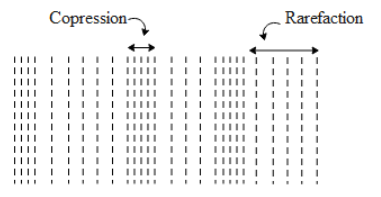
A person is listening to a tone of 500Hz sitting at a distance of 450 m sitting from the source of the sound. What is the time interval between successive compression from the source.
a) 5ms
b) 1ms
c) 2ms
d) 2s
Answer
494.7k+ views
Hint: A tone is basically a sound wave. A sound wave basically consists of a region of high pressure i.e. compression and region of low pressure i.e. rarefaction. This compression and rarefaction are periodic in nature depending on the frequency of the sound wave. Since the frequency of the wave is equal to the reciprocal of the time period we will determine the time interval between the successive compression.
Formula used:
Complete answer

Sound waves are nothing but the disturbance of the particles of the medium. A sound wave propagates a region of high pressure i.e. compression and region of low pressure I.e. rarefaction as we can see in the above diagram. These compression and rarefactions repeat themselves at regular intervals of time. The frequency of the tone heard by the man is given to be as f= 500Hz. Since the frequency of the successive compression and rarefaction of the sound wave is equal to the reciprocal of the time period, the time interval between successive compression is given by,
Hence the correct answer of the above question is option c.
Note:
The time interval of the successive compression heard by the man will be equal to the above value obtained as long as he is not moving. If the person starts moving then the frequency of the tone heard by him will be different as compared to the actual frequency of the source of the tone. The time interval of successive rarefaction heard by the man is also the same.
Formula used:
Complete answer

Sound waves are nothing but the disturbance of the particles of the medium. A sound wave propagates a region of high pressure i.e. compression and region of low pressure I.e. rarefaction as we can see in the above diagram. These compression and rarefactions repeat themselves at regular intervals of time. The frequency of the tone heard by the man is given to be as f= 500Hz. Since the frequency of the successive compression and rarefaction of the sound wave is equal to the reciprocal of the time period, the time interval between successive compression is given by,
Hence the correct answer of the above question is option c.
Note:
The time interval of the successive compression heard by the man will be equal to the above value obtained as long as he is not moving. If the person starts moving then the frequency of the tone heard by him will be different as compared to the actual frequency of the source of the tone. The time interval of successive rarefaction heard by the man is also the same.
Recently Updated Pages
Master Class 9 General Knowledge: Engaging Questions & Answers for Success

Master Class 9 English: Engaging Questions & Answers for Success

Master Class 9 Science: Engaging Questions & Answers for Success

Master Class 9 Social Science: Engaging Questions & Answers for Success

Master Class 9 Maths: Engaging Questions & Answers for Success

Class 9 Question and Answer - Your Ultimate Solutions Guide

Trending doubts
Give 10 examples of unisexual and bisexual flowers

Draw a labelled sketch of the human eye class 12 physics CBSE

Differentiate between homogeneous and heterogeneous class 12 chemistry CBSE

Differentiate between insitu conservation and exsitu class 12 biology CBSE

What are the major means of transport Explain each class 12 social science CBSE

Why is the cell called the structural and functional class 12 biology CBSE




